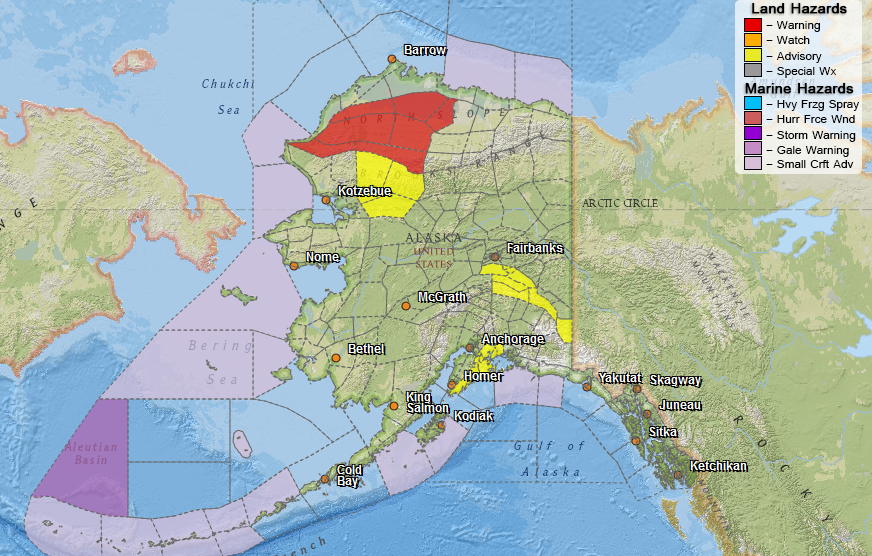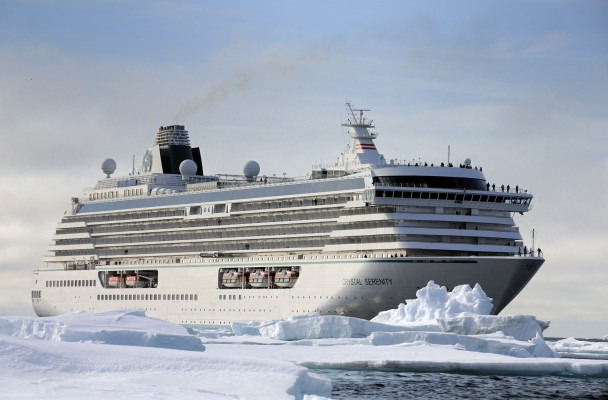The U.S. Northern Command and Coast Guard have launched a major field-training exercise off Alaska’s northwest coast. Arctic Chinook is intended to demonstrate how local, state and federal agencies would respond to a simulated cruise ship accident. Coincidentally, a big luxury cruise ship will sail through the area while the exercise is under way. And to further complicate things, bad weather has just set in.

(Photo by Gina Caylor, U.S. Coast Guard)
Coast Guard Commander Mark Wilcox said Arctic Chinook planners have had to incorporate some extra precautions into the exercise due to rough weather that set in over the weekend over the Bering and Chukchi seas.
“We are having to adapt our exercise just slightly to accommodate what is going to be gale-force winds.”
The National Weather Service had issued a gale warning effective through this evening for waters off the Seward Peninsula, where the exercise will be held. It’s also where the luxury liner Crystal Serenity and its 1,600 passengers and crew will soon be traveling through en route to the Northwest Passage and on around to New York. The weather service predicted the storm would whip up 35-to-45-knot winds off Alaska’s coast, and it issued a winter storm warning and forecast up to 8 inches of snow on the western end of the North Slope.
Wilcox said the Coast Guard and the U.S. Northern Command, or NorthCom, scheduled Arctic Chinook for now because usually it’s the best time of year to conduct such an exercise.

“We place a lot of these sort of key events – we time them for August, because we expect to get the best weather and least sea ice. But Mother Nature doesn’t always let us move forward as planned.”
Wilcox said the exercise is intended to test the ability of local, state and federal emergency responders to rescue 200 passengers from a cruise ship that’s run into trouble in those waters, The scenario calls for bringing passengers to shore around Tin City, near the westernmost tip of the Seward Peninsula – where rescuers would face their next logistical challenge. (This morning, organizers announced they’d moved the evacuation portion of the exercise to the Kotzebue Long Range Radar Site, due to rough weather.)
“So, how do we keep people alive on the beach while the secondary round of rescue assets that will bring them to an Arctic hub or village – how do we keep alive in that time span?”
The exercise scenario called for responders on the beach to triage the evacuees, sending uninjured passengers to Nome, then on to Anchorage. Fifty people will play the role of injured passengers, who’ll be taken initially to Kotzebue, said Army Col. Michael Forsyth. He’s chief of staff for Alaskan Command, the NorthCom subordinate agency based at Joint Base Elmendorf-Richardson that’s helping the Coast Guard manage the training exercise.
“There’s about 50 folks who will actually get in lifeboats. They are going to … casualties that the municipal community will have to react to.”

Forsyth said Arctic Chinook will involve up to thousand people from several agencies, along with three ships, about a dozen aircraft and many other types of equipment. He said agencies involved include U.S. Army Alaska; Air National Guard; federal Homeland Security Department and its state counterpart and the Arctic Domain Awareness Center, Homeland Security’s University of Alaska-affiliated research arm.
“Canada is also contributing to the exercise a helo, a fixed-wing aircraft and also dozens of personnel.”
Forsyth said other Arctic nations are sending observers. He said management of the complex exercise will be done out of the Alaskan Command’s facilities at JBER, where many of the agencies already have offices.
Tim Ellis is a reporter at KUAC in Fairbanks.




